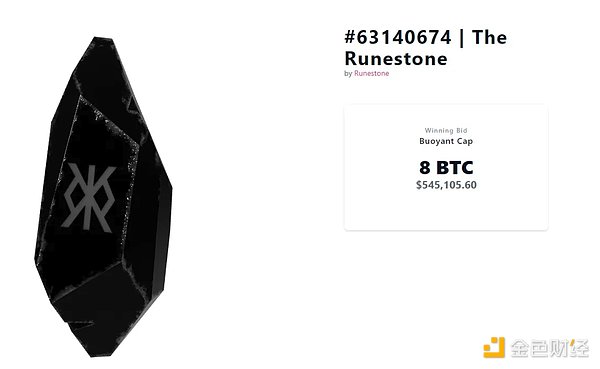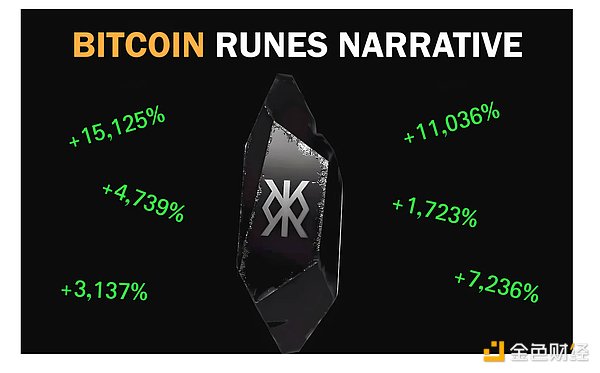Author: NFTScan Source: medium Translation: Shan Ouba, Golden Finance
Since the launch of the Ordinals protocol, there have been signs that funds and enthusiasm will spread to the field of Bitcoin NFT. With the continued appreciation of Bitcoin and the widespread acceptance of the market, the NFT ecosystem on the Bitcoin network has gradually flourished. The first batch of 10K Bitcoin Punks minted for free using Ordinals was even sold out in less than a day. This year is the booming development of the NFT ecosystem. As the enthusiasm of the crypto market continues to heat up, from the continuous improvement of infrastructure to the continuous emergence of innovative projects, and the gradual expansion of the user base, the Bitcoin NFT ecosystem is showing strong vitality.
Data shows that the volume of NFT transactions on the Bitcoin chain ranked first in the past 7 days, followed by Ethereum and Solana, and the price of Bitcoin NFT generally rose. Driven by the Runes Protocol, the Runestone base price has risen to 0.084 BTC (about $5,912), with a market value of $660 million, surpassing BAYC to become the second largest project in the NFT market, although with different positioning.

About Runes
The Runestone project is undoubtedly a shining star. It is an experimental project initiated by Leonidas, the founder of @ord_io. With the completion of the airdrop in mid-March, Runesstone has achieved amazing results. The initiative is designed to incentivize and reward early supporters who contribute to the Ordinals ecosystem. With over 110,000 unique parent-child inscriptions, Runestone not only explores digital art, but also reflects various aspects of the thriving NFT ecosystem on the Bitcoin network.
Runestone also differs significantly from traditional NFT approaches. Compared to the 10,000 total issuance that is common in NFT projects, its issuance is ten times that. The snapshot of the Runestone project was taken at block height 826,600, which marked the first anniversary of the serial number.
On March 9, Runestone #63140674 was sold for 8 BTC, equivalent to approximately $556,000. Runestone is one of the largest Bitcoin serial number inscriptions ever, with a file size of 3,967,899 bytes (3.967 MB). It is one of only seven Bitcoin ordinals that exceed 400,000 bytes (400 KB) and it was mined in block 832,947, setting a record for the largest block in Bitcoin history.
The proceeds from this auction, along with Bitcoin donations previously raised via Twitter, will be used to cover the mining costs of the Runestones airdrop program, making it one of the largest Ordinals airdrops in history. This move not only demonstrates the community's support and commitment to the Runestones project, but also increases the anticipation for the entire Bitcoin community and the upcoming launch of the Runes protocol.

Runes Protocol
Runes is a new protocol for issuing alternative tokens launched by Casey, the founder of Ordinals. It first appeared on Casey's blog and is expected to be released at the beginning of Bitcoin's halving, with a Bitcoin block height of 840,000.
Ordinals incorporates runes into the Bitcoin ecosystem and creates a centralized currency issuance mechanism in the form of indexed characters through BRC-20. However, this mechanism has brought tremendous pressure to the Ordinals protocol, which was originally developed for NFT applications. Despite being decentralized, even founder Casey can't make BRC-20 disappear. Casey has repeatedly expressed his dissatisfaction with BRC-20, saying that it takes up a lot of rune numbers and Bitcoin storage space without bringing much positive value to the ecosystem.
As a solution, Casey proposed a new protocol called Runes. The main purpose of the Runes protocol is to define a way to exchange tokenized assets on the Bitcoin network. It uses runes as the unit of tokenized assets, uses UTXO to represent rune balances, and transmits protocol messages through transaction outputs in a specific format and rules, including transfer and issuance operations.
Sponsored Business Content
Although the official Runes protocol has not yet been released, many projects related to the Runes protocol have begun to heat up in the market. Strictly speaking, there are no real Runes runes in existence, but many projects are releasing them in the form of Bitcoin NFTs. Among the projects related to the Rune protocol recently, the most popular one is probably the Runestone project.

The Road to Innovation and Vision of Runestone
The Runestone project embodies the innovative spirit of blockchain technology while adhering to the principles of fairness, transparency, and decentralization. Its distribution mechanism provides unique reward incentives for participants in the Ordinals protocol and provides a valuable example for the entire cryptocurrency community. In this way, Runestone not only establishes a healthy incentive system for the ecosystem of the Ordinals protocol, but also demonstrates how blockchain technology promotes fairness, transparency, and decentralization.
In addition, the large file size of Runestone also allows Runestone to carry richer and more complex content. Runes can contain more data and information than traditional NFTs, making them an ideal medium for digital art and cultural expression. Leonidas also emphasized that Runestone's goal is simple: to create the world's top memecoin on the Bitcoin chain, and pointed out that many people mistakenly view Runestone as just an NFT collection.
It is important to note that Runestone aims to redefine the standard NFT framework. By supporting open source algorithms, community-driven projects, fair airdrops, and rewarding early supporters, Runestone aims to subvert the traditional NFT market and build a more fair and open ecosystem. As part of the Ordinals ecosystem, Runestone is committed to promoting broader participation and innovation.
Runestone uses an open source algorithm to facilitate project verification and further community development. Open source algorithms mean that the code and technical details of the project are publicly visible, allowing anyone to view, review, and make improvements.
Runestone emphasizes returning control and ownership to the community to ensure fair participation. Through a community-driven approach, the development and decision-making of the project are no longer controlled by a single entity, but by community members who actively participate and make decisions.
Runestone adopts fair airdrops to ensure equal distribution of tokens, provide credit to early supporters and incentivize community participation. Fair airdrops ensure that every Bitcoin holder has the opportunity to obtain runestone tokens, rather than being limited to a few holders.
Each runestone is associated with an important moment in Bitcoin's history, and the larger data capacity allows for more complex multimedia content. By being linked to Bitcoin's history, the runestone adds more historical significance and cultural value, attracting a wider range of users. In addition, the larger data capacity provides more creative space and possibilities for artists and creators, enriching the content and experience of NFT.
Compared with other public chains such as Ethereum, the Bitcoin network has long been regarded as the "old guard" of crypto networks. However, with the emergence of innovations such as the Ordinals protocol, the Bitcoin network is gradually getting rid of this stereotype and reshaping its position in the field of digital asset issuance. The growing market value of Rune has sparked speculation about whether it will become the next wealth secret and whether NFT assets on the Bitcoin network will become a new industry consensus for asset issuance. Only time will tell.
 JinseFinance
JinseFinance









